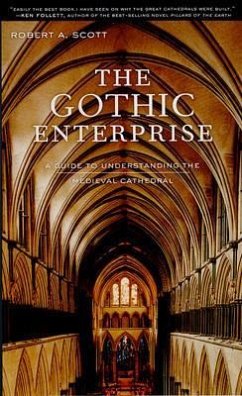Subtitled, "A Guide To Understanding The Medieval Cathedral". This stunning book helps us to understand how ordinary people managed such tremendous feats of physical and creative energy at a time when technology was rudimentary, famine and disease were rampant, the climate was often harsh, and communal life was unstable and incessantly violent.
"This is easily the best book I have seen on why the great cathedrals were built. The breadth of Scott's scholarship is astonishing. As well as art history and architecture, he brings to bear his knowledge of subjects as wide apart as engineering, the sociology of religion, and the medieval economy. Only a handful of books truly throw light on the mystery of the cathedrals, and this is one of them."--Ken Follett, author of "Pillars of the Earth"Written in a lucid style and illustrated by dozens of sketches and photographs, this interdisciplinary survey is the best introduction to its subject now in print."--Gene Brucker, author of "Florence: The Golden Age, 1138-1737"Scott has given us a book of wonderful breadth and erudition with a refreshingly light touch. He describes vividly the social, political, and religious background to the great flowering of the Gothic cathedrals of Europe in the thirteenth and fourteenth centuries, and the strange mixture of motives that drove this astonishing building program. He is equally interested in the hard practical mechanics of hewing timber, erecting scaffolding, quarrying stone, transporting and hauling these materials as he is in the religious and liturgical symbolisms and conceptual schemes of the architects and their royal paymasters. Gothic cathedrals are astounding monuments to the aspirations of the human spirit reaching out to the divine, and this is a splendid introduction to the medieval worlds that produced them, written by an enthusiastic guide who really knows his subject and loves it."--Hugh Dickinson, Dean Emeritus of Salisbury Cathedral"Gothic architecture is notoriously difficult to represent verbally, but in Scott's book the joyso many people find in discovering these breathtakingly beautiful monuments is palpable."--Stephen Murray, author of "Notre Dame, Cathedral of Amiens: The Power of Change in Gothic"In this splendid book Scott writes precisely, clearly, and with a love for both words and his readers. Those who read these pages will come away enlightened, inspired, and with a more profound grasp of our civilization."--Neil J. Smelser, University Professor of Sociology, Emeritus, University of California, Berkeley
"This is easily the best book I have seen on why the great cathedrals were built. The breadth of Scott's scholarship is astonishing. As well as art history and architecture, he brings to bear his knowledge of subjects as wide apart as engineering, the sociology of religion, and the medieval economy. Only a handful of books truly throw light on the mystery of the cathedrals, and this is one of them."--Ken Follett, author of "Pillars of the Earth"Written in a lucid style and illustrated by dozens of sketches and photographs, this interdisciplinary survey is the best introduction to its subject now in print."--Gene Brucker, author of "Florence: The Golden Age, 1138-1737"Scott has given us a book of wonderful breadth and erudition with a refreshingly light touch. He describes vividly the social, political, and religious background to the great flowering of the Gothic cathedrals of Europe in the thirteenth and fourteenth centuries, and the strange mixture of motives that drove this astonishing building program. He is equally interested in the hard practical mechanics of hewing timber, erecting scaffolding, quarrying stone, transporting and hauling these materials as he is in the religious and liturgical symbolisms and conceptual schemes of the architects and their royal paymasters. Gothic cathedrals are astounding monuments to the aspirations of the human spirit reaching out to the divine, and this is a splendid introduction to the medieval worlds that produced them, written by an enthusiastic guide who really knows his subject and loves it."--Hugh Dickinson, Dean Emeritus of Salisbury Cathedral"Gothic architecture is notoriously difficult to represent verbally, but in Scott's book the joyso many people find in discovering these breathtakingly beautiful monuments is palpable."--Stephen Murray, author of "Notre Dame, Cathedral of Amiens: The Power of Change in Gothic"In this splendid book Scott writes precisely, clearly, and with a love for both words and his readers. Those who read these pages will come away enlightened, inspired, and with a more profound grasp of our civilization."--Neil J. Smelser, University Professor of Sociology, Emeritus, University of California, Berkeley








